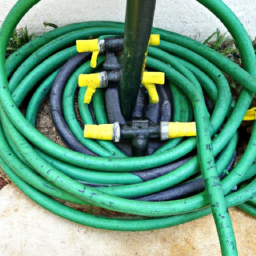Garden Hose Flow Rate How Many GPH
Table of Contents []
How Many Gph Is A Garden Hose
Introduction
Watering plants is a crucial part of gardening and is essential to an ideal garden without any hassles. However, determining how much water is needed for every garden or how many gallons per hour (GPH) is required to water every garden becomes an issue. With that in mind, this article seeks to answer the question, How many GPH is a garden hose? by offering different subtopics covering every aspect of water conservation, such as the garden hose types, water flow in a garden hose, how to calculate GPH and the connections between the garden hoses.
Types of Garden Hoses
Basically, there are two popular categories of garden hoses, the lightweight hoses and the heavy-duty hoses. Lightweight hoses are mostly used for light garden-related activities, while heavy-duty hoses are used for standard watering and normal activities. These two styles of hoses are designed to reduce unnecessary water loss in the process of watering your gardens.
1. Lightweight Garden Hoses
Lightweight garden hoses typically come with lightweight vinyl tubes that are connected to a plastic faucet. This type of hose is usually lightweight and easier to coil and maneuver around the gardenia. The lightweight hose has a fast water flow and an adjustable pressure control valve which makes it more efficient and TB. Lightweight hoses come in various shapes and sizes and best suites light-use gardens, and they can be stored inside the house when not in use. They usually range from 25 to 100 psi, and the range can be easily adjusted based on the water pressure requirement.
2. Heavy Duty Garden Hoses
Heavy-duty garden hoses are storage-friendly since they are designed to hold lots of water at once, and they usually have larger diameters. These hoses are made of durable rubber or vinyl hose pipes and have a lower water pressure than the lightweight hoses. They also come with a thicker inner tube and stronger outer layers, making them more suitable for tough outdoor activities. But the heavy duty hoses tend to be more expensive than the lightweight hoses. The heavy-duty garden hoses are usually available in 25 psi, 30 psi, and 40 psi.
Water Flow in a Garden Hose
The water flow in a garden hose depends on the size and type of hose and the water pressure used, but it can be generally calculated using the following formula:
Water Flow (GPM) (Water Pressure (PSI) x Diameter2 (Inches))/ 1714
So, the water flow in a 34-inch diameter hose at 25 PSI is approximately (25 x 34 x 34) / 1714 or approximately 2.3 gallons per minute (GPM) or 138 gallons per hour (GPH).
How to Calculate GPH
Calculating GPH in a garden hose can be done in a few easy steps. First, you need to measure the length of the hose, then measure its internal diameter. Now, you need to measure the water pressure at the source. Then, you can calculate GPH by multiplying the water pressure by the diameter of the hose and dividing it by 1714.
Connections between the Garden Hoses
It is essential to choose the right connection between the garden hoses in order to allow the water to flow properly. Normal garden hoses usually come with two types of connections, male and female. The male end is the one that connects to the tap or faucet, and the female end is the connection point where the other end of the hose is attached. Hose fittings also come in various sizes depending on the size of the hose.
Summary
Understanding how many gallons per hour (GPH) is needed for a garden hose is an essential part of gardening. Understanding the different types of hoses, the water flow, and connections between hoses are all important aspects of keeping a garden healthy and vibrant. This article has provided information on the different types of hoses, how the water flow works and how to calculate GPH, as well as the connections between the garden hoses. With all this information, you can now have a closer look at how to determine what kind of hose and how much water your gardens need and begin to ensure a healthy and successful garden.

Previous Page
Next Page
